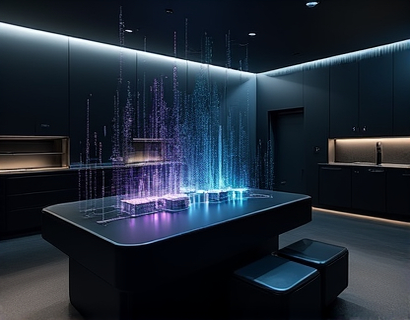Mindful Escape: Harnessing Cutting-Edge Meditation Technology for Stress Relief and Relaxation
In today's fast-paced world, stress has become an almost constant companion for many individuals. The relentless demands of work, personal responsibilities, and the continuous influx of information can lead to mental fatigue and emotional strain. Finding effective methods to manage stress and achieve a state of relaxation is more crucial than ever. One promising avenue is the integration of advanced meditation technology, designed to guide users through transformative relaxation experiences. This article explores the benefits and functionalities of cutting-edge meditation software, which combines guided sessions, calming soundscapes, and mindfulness tools to promote deep relaxation and stress relief.
Meditation, a practice rooted in ancient traditions, has gained significant attention in modern times for its proven benefits in reducing stress, enhancing mental clarity, and improving overall well-being. Traditional meditation involves focusing the mind on a particular object, thought, or activity to train attention and awareness, and achieve a mentally clear and emotionally calm state. However, for many beginners, the process can seem daunting, leading to inconsistent practice and limited results. The introduction of technology into meditation has addressed these challenges, making the practice more accessible and effective for a broader audience.
Advanced Meditation Software: A Comprehensive Toolkit
Modern meditation software is designed to cater to the diverse needs of individuals seeking relaxation and stress relief. These platforms offer a range of features that enhance the meditation experience, making it easier for users to integrate mindfulness into their daily lives. At the core of these tools are guided meditation sessions, which are essential for beginners and experienced practitioners alike.
Guided meditation sessions are led by experienced instructors who walk users through each step of the meditation process. These sessions cover various themes, from stress reduction and sleep improvement to focus enhancement and emotional balance. The guidance provided helps users maintain focus, preventing the mind from wandering and ensuring a more profound meditation experience. For those new to meditation, these sessions serve as a gentle introduction, building confidence and familiarity with the practice.
One of the key advantages of meditation software is the variety of guided sessions available. Users can choose from different lengths, ranging from quick 5-minute sessions to more extended 30-minute or hour-long practices. This flexibility allows individuals to fit meditation into their busy schedules, whether it's during a lunch break, before bed, or in the morning to start the day with a clear mind.
Calming Soundscapes: Enhancing the Meditation Experience
Sound plays a crucial role in meditation, helping to create an immersive environment that promotes relaxation and mental clarity. Meditation software often includes a library of calming soundscapes, which can significantly enhance the meditation experience. These soundscapes range from gentle nature sounds like flowing water, rustling leaves, and bird songs to more abstract sounds designed to induce a state of deep relaxation.
The use of soundscapes in meditation is based on the principle that certain sounds can influence brainwave activity, helping to shift the mind into a more relaxed state. For example, the sound of rain or ocean waves can lower heart rate and blood pressure, reducing stress and anxiety. By incorporating these soundscapes into meditation sessions, users can more easily achieve a state of deep relaxation, making the practice more effective and enjoyable.
Meditation software typically allows users to customize their soundscapes, mixing different elements to create a personalized auditory environment. This customization option ensures that each meditation session is unique, keeping the practice fresh and engaging. Whether it's the soothing sound of a babbling brook or the gentle hum of a cityscape, users can tailor their soundscape to match their mood and environment, enhancing the overall meditation experience.
Mindfulness Tools: Cultivating Present-Moment Awareness
Beyond guided sessions and soundscapes, meditation software often includes a variety of mindfulness tools designed to help users cultivate present-moment awareness. Mindfulness is the practice of being fully present and engaged in the current moment, without judgment. This practice has been shown to reduce stress, improve emotional regulation, and enhance overall mental well-being.
One of the key mindfulness tools available in meditation software is the breath awareness exercise. This simple yet powerful technique involves focusing attention on the breath, observing its natural rhythm and flow. By concentrating on the breath, users can anchor themselves in the present moment, letting go of distracting thoughts and worries. This practice not only calms the mind but also helps to develop greater self-awareness and emotional resilience.
Another useful tool is the body scan meditation, which involves systematically bringing attention to different parts of the body. This practice helps users become more attuned to physical sensations, promoting relaxation and reducing tension. By scanning from the toes to the head, users can release stored stress and tension, fostering a sense of physical and mental balance.
Meditation software may also include journaling prompts and reflection exercises, encouraging users to explore their thoughts and emotions in a structured way. These tools help users gain insights into their mental patterns and behaviors, supporting personal growth and self-awareness. By integrating these mindfulness tools into their daily routine, users can develop a more mindful approach to life, leading to greater peace and fulfillment.
User-Friendly Interface: Making Meditation Accessible
The success of meditation software hinges on its user-friendliness. A well-designed interface ensures that users of all technical backgrounds can easily navigate the platform and access the various features. Intuitive menus, clear instructions, and visually appealing designs make the experience enjoyable and stress-free.
One of the key features of user-friendly meditation software is the ability to track progress and set goals. Users can log their meditation sessions, view statistics on their practice, and set personalized goals to stay motivated. This functionality not only helps users maintain consistency but also provides a sense of accomplishment as they witness their progress over time.
Additionally, many meditation platforms offer a community aspect, where users can connect with others, share experiences, and participate in group meditations. This sense of community can be particularly beneficial for those who feel isolated in their meditation journey, providing support and encouragement from like-minded individuals.
Scientific Backing: The Evidence for Meditation's Benefits
The effectiveness of meditation in reducing stress and promoting relaxation is supported by a growing body of scientific research. Studies have shown that regular meditation practice can lead to significant changes in brain structure and function, particularly in areas associated with attention, emotion regulation, and stress response.
For instance, research using neuroimaging techniques has demonstrated that meditation can increase gray matter density in the hippocampus, a brain region involved in learning, memory, and emotional regulation. This increase in gray matter is associated with improved cognitive function and emotional resilience. Additionally, meditation has been shown to reduce activity in the amygdala, the brain's fear center, leading to a decrease in stress and anxiety levels.
Furthermore, meditation has been found to enhance the production of neurotransmitters like serotonin and GABA, which play crucial roles in mood regulation and stress reduction. These biochemical changes contribute to the overall sense of well-being and calmness experienced by meditators. As more research continues to emerge, the scientific community increasingly recognizes meditation as a valuable tool for mental health and stress management.
Integrating Meditation into Daily Life
While the benefits of meditation are well-documented, the challenge lies in making it a consistent part of daily life. Meditation software serves as a practical solution, providing a structured and supportive environment for regular practice. By incorporating meditation into daily routines, individuals can experience the long-term benefits of reduced stress, improved focus, and enhanced emotional well-being.
To integrate meditation into daily life, users can start with short, manageable sessions and gradually increase the duration as they become more comfortable with the practice. Setting a specific time each day, such as in the morning or before bed, can help establish a consistent routine. Additionally, using meditation software's reminders and notifications can serve as gentle prompts to stay on track.
It's also important to create a conducive environment for meditation. This can be as simple as finding a quiet corner in the home, using a comfortable cushion or chair, and minimizing distractions. Some users find it helpful to incorporate meditation into existing routines, such as during a morning coffee break or before starting work, making it a seamless part of their day.
Conclusion: Embracing a Mindful Lifestyle
In conclusion, meditation technology offers a powerful and accessible way to experience the profound benefits of mindfulness and relaxation. Through guided sessions, calming soundscapes, and mindfulness tools, meditation software empowers individuals to manage stress, enhance mental clarity, and foster a more balanced life. As more people recognize the importance of mental well-being, the integration of meditation into daily routines becomes increasingly valuable.
By embracing this mindful lifestyle, individuals can not only improve their own well-being but also positively impact those around them. The ripple effect of reduced stress and increased compassion can lead to more harmonious relationships and a more peaceful society. As technology continues to evolve, the potential for meditation to transform lives remains vast, offering a path to a more mindful and fulfilling existence.










































